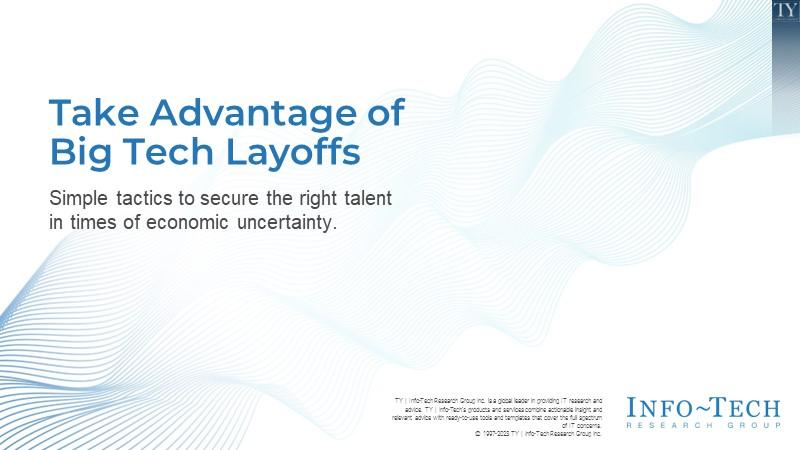
Take Advantage of Big Tech Layoffs
Tech layoffs have been making the news over the past year, with thousands of Big Tech employees having been laid off. After years of record low unemployment in IT, many leaders are looking to take advantage of these layoffs to fill their talent gaps.
However, IT leaders need to determine their response – wait and see the impact of the recession on budgets and candidate expectations, or dive in and secure great talent to execute today on strategic needs. This research is designed to help those IT leaders who are looking to take advantage employee effective talents to secure talent.
- With the impact of the economic slowdown still unknown, the first question IT leaders need to ask is whether now is the time to act.
- Even with these layoffs, IT unemployment rates are at record lows, with many organizations continuing to struggle to attract talent. While these layoffs have opened a window, IT leaders need to act quickly to secure great talent.
Our Advice
Critical Insight
The “where has the talent gone?” puzzle has been solved. Many tech firms over-hired and were able to outcompete everyone, but it wasn’t sustainable. This correction won’t impact unemployment numbers in the short term – the job force is just in flux right now.
Impact and Result
This research is designed to help IT leaders understand the talent market and to provide winning tactics to those looking to take advantage of the layoffs to fill their hiring needs.
Take Advantage of Big Tech Layoffs Research & Tools
Besides the small introduction, subscribers and consulting clients within this management domain have access to:
1. Take Advantage of Big Tech Layoffs Storyboard – A snapshot of the current talent market in IT and quick tactics IT leaders can employ to improve their hiring process to find and attract tech talent.
Straightforward tactics you can execute to successfully recruit IT staff impacted by layoffs.
- Take Advantage of Big Tech Layoffs Storyboard
2. IT Talent Acquisition Optimization Tool – Use this tool to document the current and future talent acquisition process.
To hire efficiently, create a clear, consistent talent acquisition process. The IT Talent Acquisition Process Optimization Tool will help to:
- IT Talent Acquisition Optimization Tool
Further reading
Take Advantage of Big Tech Layoffs
Simple tactics to secure the right talent in times of economic uncertainty.
Why are the layoffs making the news?
After three years of record low unemployment rates in IT and organizations struggling to hire IT talent into their organization, the window appears to be opening with tens of thousands layoffs from Big Tech employers.
Big brand organizations such as Microsoft, Alphabet, Amazon, Twitter, Netflix, and Meta have been hitting major newswires, but these layoffs aren't exclusive to the big names. We've also seen smaller high-growth tech organizations following suit. In fact, in 2022, it's estimated that there were more than 160,997 layoffs across over 1,045 tech organizations. This trend has continued into 2023. By mid-February 2023, there were already 108,754 employees laid off at 385 tech companies (Layoffs.fyi).(1)
While some of these layoffs have been openly connected to economic slowdown, others are pointing to the layoffs being a correction for over-hiring during the pandemic. It is also important to note that many of these workers were not IT employees, as these organizations also saw cuts across other areas of the business such as sales, marketing, recruitment, and operations.
(1)This global database is constantly being updated, and these numbers are changing on an ongoing basis. For up-to-date statistics, see https://layoffs.fyi
While tech layoffs have been making the news, so far many of these layoffs have been a correction to over-hiring, with most employees laid off finding work, if they want it, within three months.
IT leaders need to determine their response – wait and see the impact of the recession on budgets and candidate expectations or dive in and secure great talent to execute today on strategic needs.
This research is designed to help IT leaders understand the talent market and provide winning strategies to those looking to take advantage of the layoffs to fill their hiring needs.
Three key drivers for Big Tech layoffs
Economic uncertainty
Globally, economists are predicting an economic slowdown, though there is not a consistent prediction on the impact. We have seen an increase in interest rates and inflation, as well as reduced investment budgets.
Over-hiring during the pandemic
High growth and demand for digital technologies and services during the early pandemic led to over-hiring in the tech industry. Many organizations overestimated the future demand and had to rebalance staffing as a result.
New automation investments
Many tech organizations that have conducted layoffs are still in a growth mindset. This is demonstrated though new tech investments by these companies in products like chatbots and RPA to semi-automate processes to reduce the need for certain roles.
Despite layoffs, the labor market remains competitive
There were at least 160,997 layoffs from more than 1,045 tech companies last year (2022). (Layoffs.fyi reported as of Feb 21/2023)
But just because Big Tech is laying people off doesn't mean the IT job market has cooled.
Between January and October 2022 technology- focused job postings rose 25% compared to the same period in 2021, and there were more than 375,000 tech jobs posted in October of 2022.
(Dice: Tech Jobs Report.)
Info-Tech Insight
The "where has the talent gone?" puzzle has been solved. Many tech firms over-hired and were able to outcompete everyone, but it wasn't sustainable. This correction won't impact unemployment numbers in the short term – the job force is just in flux right now.
So far, many of the layoffs have been a market correction
Tech Layoffs Since COVID-19
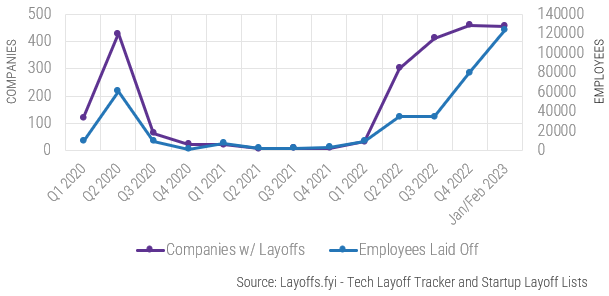
Source: Layoffs.fyi - Tech Layoff Tracker and Startup Layoff Lists
Tech Companies Layoffs vs. Early Pandemic Hiring # of People
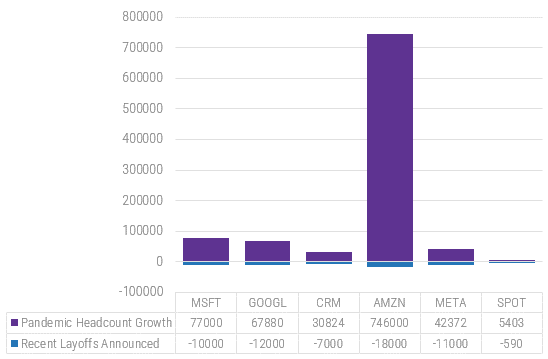
Source: Yahoo Finance. Q4 '19 to Q3 '22
Tech Layoffs between 2020 Q3- 2022 Q1 remained very low across the sector. In fact, outside of the initial increase at the start of the pandemic, layoffs have remained at historic low levels of around 1% (HBR, 2023). While the layoffs look significant in isolation, when you compare these numbers to pandemic hiring and growth for these organizations, the figures are relatively small.
The first question IT leaders need to ask is whether now is the time to act
The big gamble many CIOs face is whether to strike now to secure talent or to wait to better understand the impact of the recession. While two-thirds of IT professionals are still expecting their budgets to increase in 2023, CIOs must account for the impact of inflation and the recession on their IT budgets and staffing decisions (see Info-Tech's CEO-CIO Alignment Program).
Ultimately, while unemployment is low today, it's common to see unemployment numbers drop right before a recession. If that is the case, then we will see more talent entering the market, possibly at more competitive salaries. But organizations that wait to hire risk not having the staff they need to execute on their strategy and finding themselves in a hiring freeze. CIOs need to decide on how to approach the economic uncertainty and where to place their bets.
Looking ahead to 2023, how do you anticipate your IT spending will change compared to spending in 2022?

Info-Tech's CEO-CIO Alignment Program
Organizations ready to take advantage will need to act fast when layoffs happen
Organizations looking to fill hiring needs or grow their IT/digital organization will need to be strategic and efficient when it comes to recruitment. Regardless of the number of layoffs, it continues to be an employee market when it comes to IT roles.
While it is likely that the recession will impact unemployment rates, so far, the market remains hot, and the number of open roles continues to grow. This means that organizations that want to take advantage need to act quickly when news hits.
Leaders not only need to compete with other organizations for talent, but the other challenge hiring organizations will need to compete with is that many in tech received generous severance packages and will be considering taking time off. To take advantage, leaders need to establish a plan and a clear employee value proposition to entice these highly skilled workers to get off the bench.
Why you need to act fast:
- Unemployment rates remain low:
- Tech unemployment's rates in the US dropped to 1.5% in January 2023 (CompTIA), compared to overall unemployment which is at 3.4% in the US as of January 2023 (Yahoo Finance). While the layoffs look significant, we can see that many workers have been rehired into the labor market.
- Long time-to-hire results in lost candidates:
- According to Info-Tech's IT Talent Trend Report, 58% of IT leaders report time-to-hire is longer than two months. This timing increases for tech roles which require unique skills or higher seniority. IT leaders who can increase the timeline for their requirement process are much more likely to be able to take advantage of tech layoffs.
IT must take a leading role in IT recruitment to take advantage of layoffs
A personal connection is the differentiator when it comes to talent acquisition
There is a statistically significant relationship between IT leadership involvement in talent acquisition and the effectiveness of this process in the IT department. The more involved they are, the higher the effectiveness.(1)
More IT leadership involvement |
 |
Higher recruitment effectiveness |
Involved leaders see shorter times to hire
There is a statistically significant relationship between IT leadership involvement in the talent acquisition process and time to fill vacant positions. The more involved they are, the shorter the time to hire.(2)
Involved leaders are an integral part of effective IT departments
There is a statistically significant relationship between IT leadership involvement in talent acquisition and overall IT department effectiveness. Those that are more involved have higher levels of effectiveness.(3)
Increased IT Leadership in Recruitment Is Directly Correlated to Recruitment Effectiveness.
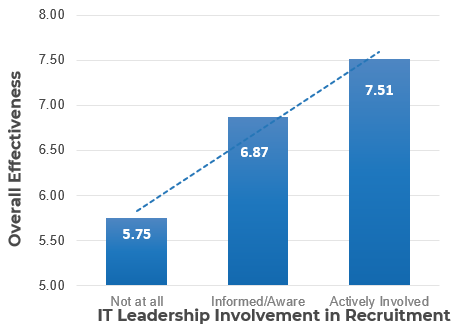
Focus your layoff recruitment strategy on critical and strategic roles
If you are ready to take advantage of tech layoffs, focus hiring on critical and strategic roles, rather than your operational backfills. Roles related to security, cloud migration, data and analytics, and digital transformation are more likely to be shielded from budget cuts and are logical areas to focus on when looking to recruit from Big Tech organizations.
Additionally, within the IT talent market, scarcity is focused in areas with specialized skill sets, such as security and architecture, which are dynamic and evolving faster than other skill sets. When looking to recruit in these areas, it's critical that you have a targeted recruitment approach; this is why tech layoffs represent a strong opportunity to secure talent in these specialized areas.
ROLES DIFFICULT TO FILL
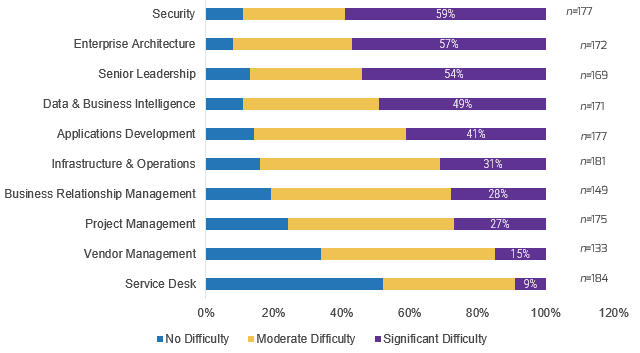
Info-Tech Talent Trends 2022 Survey
Four quick tactics to take advantage of Big Tech layoffs
TALENT ACQUISITION PROCESS TO TAKE ADVANTAGE OF LAYOFFS
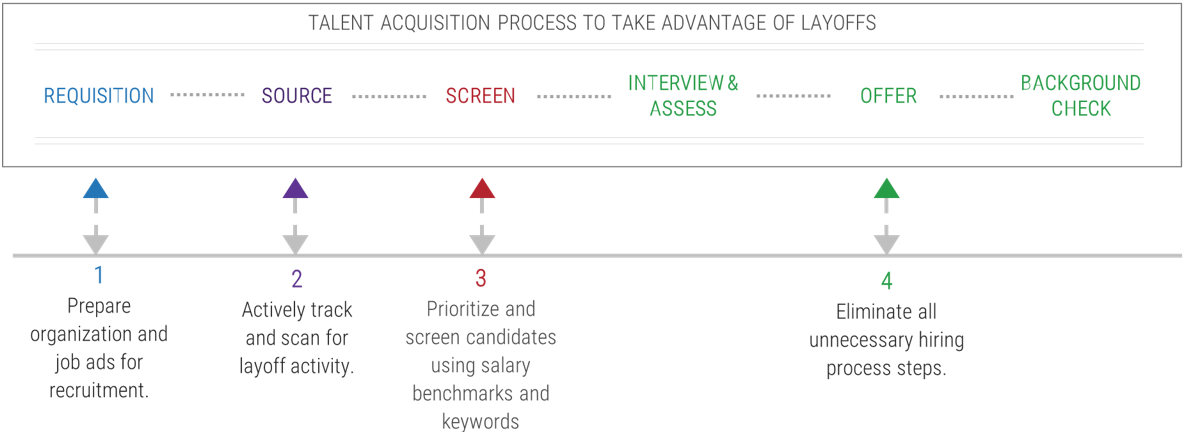
Guided Implementation
What does a typical GI on this topic look like?
| Step 1 | Step 2 | Step 3 | Step 4 |
|---|---|---|---|
Call #1: Scope requirements, objectives, and your specific challenges. |
Call #2: IT job ad review. |
Call #4: Identify screening and sourcing opportunities. |
Call #5: Review your IT talent acquisition process. |
Call #3: Employee value proposition review. |
Call #7: Refine your talent acquisition process. |
A Guided Implementation (GI) is a series of calls with an Info-Tech analyst to help implement our best practices in your organization.
A typical GI is 8 to 12 calls over the course of 4 to 6 months.
Tactics to take advantage of tech layoffs
Activities
1.1 Spot check your employee value proposition
1.2 Update job advertisements
1.3 Document your talent acquisition process
1.4 Refine your talent acquisition process
This step involves the following participants:
- IT executive leadership
- IT hiring manager
- Human resources
- Marketing/public relations
Outcomes of this step
Streamlined talent acquisition process tailored to take advantage of tech layoffs.

Requisition: update job ads and secure approval to hire
Critical steps:
- Ensure you have secured budget and hiring approval.
- Identify an IT recruitment partner within the IT organization who will be accountable for working with HR throughout the process and who will actively track and scan for recruitment opportunities.
- Update your IT job descriptions.
- Spot check your employee value proposition (EVP) to appeal to targeted candidates (Exercise 1.1).
- Write employee job ads for relevant skills and minimum viable experience (Exercise 1.2).
- Work with HR to develop your candidate outreach messages – ensure that your outreach is empathetic, aligns with your EVP, and focuses on welcoming them to apply to a role.
The approval process to activate a requisition can be one of the longest stages in the talent acquisition process. Ensure all your roles are up to date and approved so you can trigger outreach as soon as news hits; otherwise, you'll be late before you've even begun.
Your employee value proposition (EVP) is a key tool for attracting and retaining talent
Any updates to your EVP need to be a genuine reflection of the employee experience at your organization – and should resonate internally and externally.
Internal (retention) perspective: These characteristics help to retain new and existing talent by ensuring that new hires' expectations are met and that the EVP is experienced throughout the organization.
External (attraction) perspective: These characteristics help to attract talent and are targeted so the right candidates are motivated to join, while those who aren't a good fit will self-select out.
McLean & Company's Employee Value Proposition Framework

Source: McLean & Company
1.1 Spot check your EVP
1-3 hours
- Review your existing IT employee value proposition. If you do not have an EVP, see Info-Tech's comprehensive research Improve the IT Recruitment Process to draft a new EVP.
- Invite a representative group of employees to participate in a working group to improve your employee value proposition. Ask each participant to brainstorm the top five things they value most about working at the organization.
- Consider the following categories: work environment, career advancement, benefits, and ESG and diversity impact. Brainstorm as a group if there is anything unique your organization offers with regard to these categories.
- Compare your notes to your existing EVP, identify up to four key statements to focus on for the EVP, ensuring that your EVP speaks to at least one of the categories above. Remove any statements that no longer speak to who you are as an organization or what you offer.
Input
- Existing employee value proposition
- Employee Engagement Surveys (If Available)
Output
- Updated employee value proposition
Materials
- Whiteboard/flip charts
- Job ad template
Participants
- Representative group of internal employees.
- HR
- Marketing/PR (if possible)
Four critical factors considered by today's job seeker
- Be specific about remote work policies: Include verbiage about whether there is an option to work hybrid or remote. 81% of job seekers stated that whether a job is remote, hybrid, or in-person was a top factor in whether they'd accept an offer (Benefits Canada, 2022).
- Career advancement and stability: "37% of Gen Z employees and 25% of millennial employees are currently looking for a job that offers career progression transparency — or, in other words, a job with clear opportunities for growth. This is significantly higher than our findings for older generations Gen X (18%) and baby boomers (7%)," (Lattice, 2021).
- Unique benefits: Consider your unique benefits – it's not the Big Tech "fun perks" like slides and ping pong that drive interest. Employees are increasingly looking for roles with long-term benefits programs. 90% of job seekers consider higher pension contributions to be a key factor, and 85% are considering bonuses/profit sharing" (Benefits Canada, 2022). Candidates may accept lower total compensation in exchange for flexibility, culture, work/life balance that was lacking in the start-up scene or the mega-vendors' fast-paced world.
- ESG and diversity impact: Include details of how the candidate will make a societal impact through their role, and how the company is acting on climate and sustainability. "Nearly two in five [Gen Z's and millennials] say they have rejected a job or assignment because it did not align with their values," (Deloitte Global, 2022).
Update or establish job ads for candidate outreach
Take the time up front to update your IT job descriptions and to write effective job advertisements. A job advertisement is an external-facing document that advertises a position with the intent of attracting job applicants. It contains key elements from the job description as well as information on the organization and its EVP. A job description informs a job ad, it doesn't replace it.
When updating job descriptions and job ads, it's critical that your requirements are an accurate representation of what you need in the position. For the job ads especially, focus on the minimum requirements for the role, highlight your employee value proposition, and ensure that they are using inclusive language.
Don't be lulled into using a job description as a posting when there's a time crunch to fill a position – use your preparation time to complete this key step.
Three tips to consider when building a job ad
Include the minimum desired requirements
Include the required skills, responsibilities, and certifications required. Instead of looking for a unicorn, look for what you need and a demonstrated ability to learn. 70% of business executives say they are getting creative about sourcing for skills rather than just considering job experience (Deloitte Insights, 2022).
Strategically include certifications
When including certifications, ensure you have validated the process to be certified – i.e. if you are hiring for a role with 3-5 years' experience, ensure that the certification does not take 5-10 years of experience be eligible.
Use inclusive language
Consider having a review group within your IT organization to ensure the language is inclusive, that the responsibilities don't read as overly complex, and that it is an accurate representation of the organization's culture.
1.2 Update or build job ads
1-3 hours
- Begin with a copy of the job ad you are looking to fill, if you haven't begun to draft the role, start with Info-Tech's Job Description Library and Info-Tech's Job Ad Template.
- Review the job accountabilities, rank each responsibility based on its importance and volume of work. Determine if there are any responsibilities that are uncommon to be executed by the role and remove unnecessary responsibilities.
- For each of the job accountabilities, identify if there is a level of experience, knowledge or competency that would be the minimum bar for a candidate. Remove technical skills, specific technologies, and competencies that aren't directly relevant to the role, responsibilities or values.
- Review the education and requirements, and ensure that any certification or educational background is truly needed or suggested.
- Use the checklist on the following tab to review and update your job ad.
Input
- Job description
- Employee value proposition
- Job ad template
Output
- Completed job ad
Materials
- Whiteboard/flip charts
- Web share
Participants
- Representative group of internal employees.
- HR
- Marketing/PR (if possible)
1.2 Job ad checklist:
A job ad needs to be two things: effective and inclusive.
Effective |
|
The job ad does include: |
|
| The organization's logo. | |
| Description of the organization. | |
| Information about benefits. | |
| A link to the organization's website and social media platforms. | |
| Steps in the application process and what candidates can expect. | |
The job ad: |
|
| Paints an accurate picture of key aspects of the role. | |
| Tells a story to show potential candidates how the role and organization will fit into their career path (outlines potential career paths, growth opportunities, training, etc.). | |
| Does not contain too many details and tasks that would overwhelm applicants. | |
| Highlights the employer brand in a manner that conveys the EVP and markets the organization to attract potential applicants. | |
| Includes creative design or formatting to make the ad stand out. | |
| The job ad speaks to the audience by using targeted language (e.g. using creative language when recruiting for a creative role). | |
| The job ad has been reviewed by HR, Marketing, PR. | |
Inclusive |
|
The job ad does NOT include: |
|
| Industry jargon or abbreviations that are not spelled out. | |
| Personality characteristics and unnecessary adjectives that would deter qualified candidates (e.g. extroverted, aggressive, competitive). | |
| A list of specific academic disciplines or schools, GPA requirements, or inflated degree requirements. | |
The job ad: |
|
| Uses gender-neutral language and does not contain terms that indicate traits that are typically associated with a specific gender. | |
| Can be viewed and applications can be completed on mobile devices. | |
| Focuses on results, day-to-day requirements, competencies, and transferrable skills. | |
| Includes design that is accessible (e.g. alternative text is provided for images, clear posting structure with headings, color is not used to convey information). | |
Sourcing: Set up news trackers and review layoff source lists
- Set up news and social media trackers to track layoff updates, and ensure you have an IT staff member on standby to complete a more detailed opportunity analysis when layoffs happen.
- Use layoff source lists such as Layoffs.fyi to actively track organizations that have laid people off, noting the industry, location, and numbers in order to identify potential candidates. Limit your future analysis to locations that would be geographically possible to hire from.
- Review open-source lists of laid-off employees to quickly identify potential candidates for your organization.
- Many organizations that have completed layoffs have established outplacement programs to help laid-off staff find new roles. Set a plan in motion with HR to reach out to organizations once a layoff has occurred to understand their layoff support program.
The key to successful sourcing is for IT to take an active role in identifying which organizations impacted by layoffs would be a good fit, and to quickly respond by searching open-source lists and LinkedIn to reach out potential candidates.
Consider leveraging open-source lists
Layoffs.fyi has been tracking and reporting on layoffs since the start of COVID-19. While they are not an official source of information, the site has more than a million views per month and is a strong starting point for IT leaders looking to source candidates from tech layoffs beyond the big organizations that are making the news.
The site offers a view of companies with layoffs by location, industry, and the source of the info. Additionally, it often lists the names and contact information of laid-off employees, which you can leverage to start your deeper LinkedIn outreach or candidate screening.
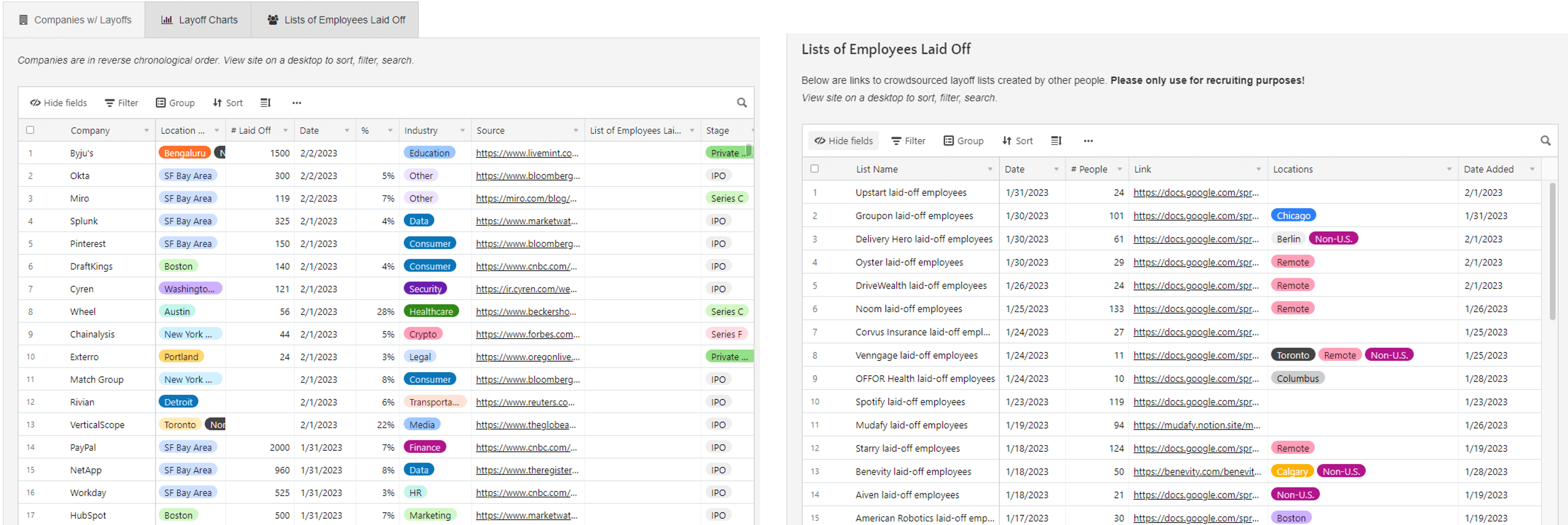
Screenshots from Layoffs.fyi.
Screening: Prioritize by considering salary benchmarks and keywords
- Determine a set of consistent pre-screening questions to leverage while screening candidates, which every candidate must answer, including knockout questions.
- Prioritize by going for salary ranges you can afford: It is important to be aware of what companies are paying within the tech arena, so you know if your salary bands are within a competitive range.
- Pre-screen resumes using appropriate keywords that are critical for the role, and widen the terms if you do not have enough candidates. Given the pool you are looking to recruit from, consider removing criteria specifically related to education or certifications; instead, prioritize skills and on-the-job experience.
Screening is one of the most time-consuming stages of the TA process. For each open position, it can take 23 hours to screen resumes (Toolbox, 2021). In fact, 52% of TA leaders believe that screening candidates from a large pool of applicants is the hardest part of recruitment (Ideal, 2021).
Compensation comparison reports
Keep in mind that the market may be shifting rapidly as layoffs proliferate, so what the data shows, particularly on free-to-use sites with little data-checking, may not be current and may be overstated. Info-Tech does not provide salary analysis; however, there are publicly available reports and online websites with self-reported data.
This list contains several market data sources for the tech industry, which may be a good starting point for comparison. Info-Tech is not affiliated with or endorsing any of these market data sources.
Work with your HR partner to streamline your talent acquisition process
A slow talent acquisition process presents multiple risks to your ability to recruit. Candidates are likely having multiple hiring conversations, and you could lose a good candidate just by being slower than another organization. Additionally, long hiring processes are also an indicator of a high level of bureaucracy in an organization, which may turn off tech candidates who are used to faster-paced decision making.
Reducing your time-to-hire needs to be a strategic priority, and companies that manage to do this are reaping the benefits: There is a statistically significant relationship between time to fill vacant positions and overall IT department effectiveness. The shorter the time to fill a position, the higher the effectiveness (Bika, 2019).
Key Considerations for Optimizing your Talent Acquisition Process
Key Considerations for Optimizing your Talent Acquisition Process |
|
|---|---|
Review the end-to-end experience |
|
50% |
of job seekers surveyed had "declined a job offer due to poor [candidate] experience," (Echevarria, 2020). |
Reduce the time to hire |
|
55% |
"of candidates believe that it should take one to two weeks from the first interview to being offered the job," (Duszyński, 2021). |
Be clear on Timelines |
|
83% |
"of candidates say it would greatly improve the overall experience if employers provided a clear timeline of the hiring process," (Miller, n.d.). |
Time to hire: Identify solutions to drive efficient hiring
- Document all steps between screening and hiring and remove any unnecessary steps.
- Create clearly defined interview guides to ensure consistent questioning by interviewers.
- Enable hiring managers to schedule their own interviews.
- Determine who needs to approve an offer. Streamline the number of approvals, if possible.
- Eliminate unnecessary background checks. Many companies have eliminated reference checks, for example, after determining that it was it was not adding value to their decision.
- Identify and track key metrics across your talent acquisition process.
It is critical to partner with your HR department on optimizing this process, as they are typically the process owners and will have deep knowledge of the rationale for decisions. Together, you can identify some opportunities to streamline the process and improve the time to hire.
4.1 Document your TA process
1-3 hours
- If you have a documented talent acquisition process, begin with that; if not, open the IT Talent Acquisition Process Optimization Tool and map the stages of the talent acquisition process with your HR leader. Stages are the top level in the process (e.g. requisition, sourcing, screening).
- Identify all the stakeholders involved in IT talent acquisition and document these in the tool.
- Next, identify the steps required for each stage. These are more detailed actions that together will complete the stage (e.g. enter requisition into ATS, intake meeting). Ask subject matter experts to add steps to their portion of the process and document these in the cells.
- For each step in the stage, record the time required and the number of people who are involved.
Input
- Existing talent acquisition (TA) process document
- Any TA process metrics
- Info-Tech's Talent Acquisition Process Optimization Tool
Output
- Documented TA process
Materials
- Info-Tech's Talent Acquisition Process Optimization Tool
- Whiteboard/flip charts
- Sticky notes
Participants
- HR
- IT leaders
- Hiring manager
Download the IT Talent Acquisition Process Optimization Tool
Example of steps in each stage of the TA process
Activities |
Requisition |
Source |
Screen |
Interview & Assess |
Offer |
Background Check |
|---|---|---|---|---|---|---|
| Vacancy identified | Posted on website | Resumes screened in system | Interviews scheduled | Offer letter drafted | Reference checks conducted | |
| Requisition submitted | Posted on job boards | Resume screened by recruited | First round interviews | Offer letter sent | Medical checks conducted | |
| Requisition approved | Identification of layoff sources | Resumed reviewed by hiring manager | Assessment | Negotiations | Other background checks conducted | |
| Job description updated | Review layoff source lists | Screening calls | Second round interview | First date confirmed | ||
| Job ad updated | Screening questions developed | Candidates selected | ||||
| Intake meeting |
4.2 Refine your TA process
1-3 hours
- Collectively identify any:
- Inconsistent applications: Activities that are done differently by different participants.
- Bottlenecks: A place in the process where activity is constrained and holds up next steps.
- Errors: When a mistake occurs requiring extra time, resources, or rework.
- Lack of value: An activity that adds little to no value (often a legacy activity).
- Work with HR to identify any proposed solutions to improve consistency, reduce bottlenecks, errors, or eliminate steps that lack value. Document your proposed solutions in tab 3 of the IT Talent Acquisition Optimization Tool.
- Identify any new steps needed that would drive greater efficiency, including the tactics suggested in this research. Document any proposed solutions in tab 3.
- For each proposed solution, evaluate the general level of effort and impact required to move forward with that solution and select the appropriate classification from the drop-down.
- Determine if you will move forward with the proposed solution at this time. Update the TA workflow with your decisions.
Input
- Existing talent acquisition (TA) process document
- Any TA process metrics
- Info-Tech's Talent Acquisition Process Optimization Tool
Output
- Documented TA process
Materials
- Info-Tech's Talent Acquisition Process Optimization Tool
- Whiteboard/flip charts
- Sticky notes
Participants
- HR
- IT leaders
- Hiring manager
Use Info-Tech's IT Talent Acquisition Optimization Tool to document current challenges & target solutions.
Map your process and identify opportunities to streamline
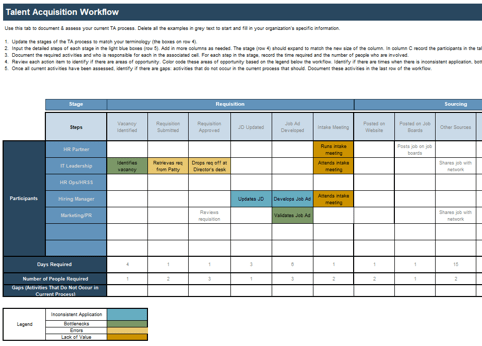
Brainstorm and select solutions to improve your process
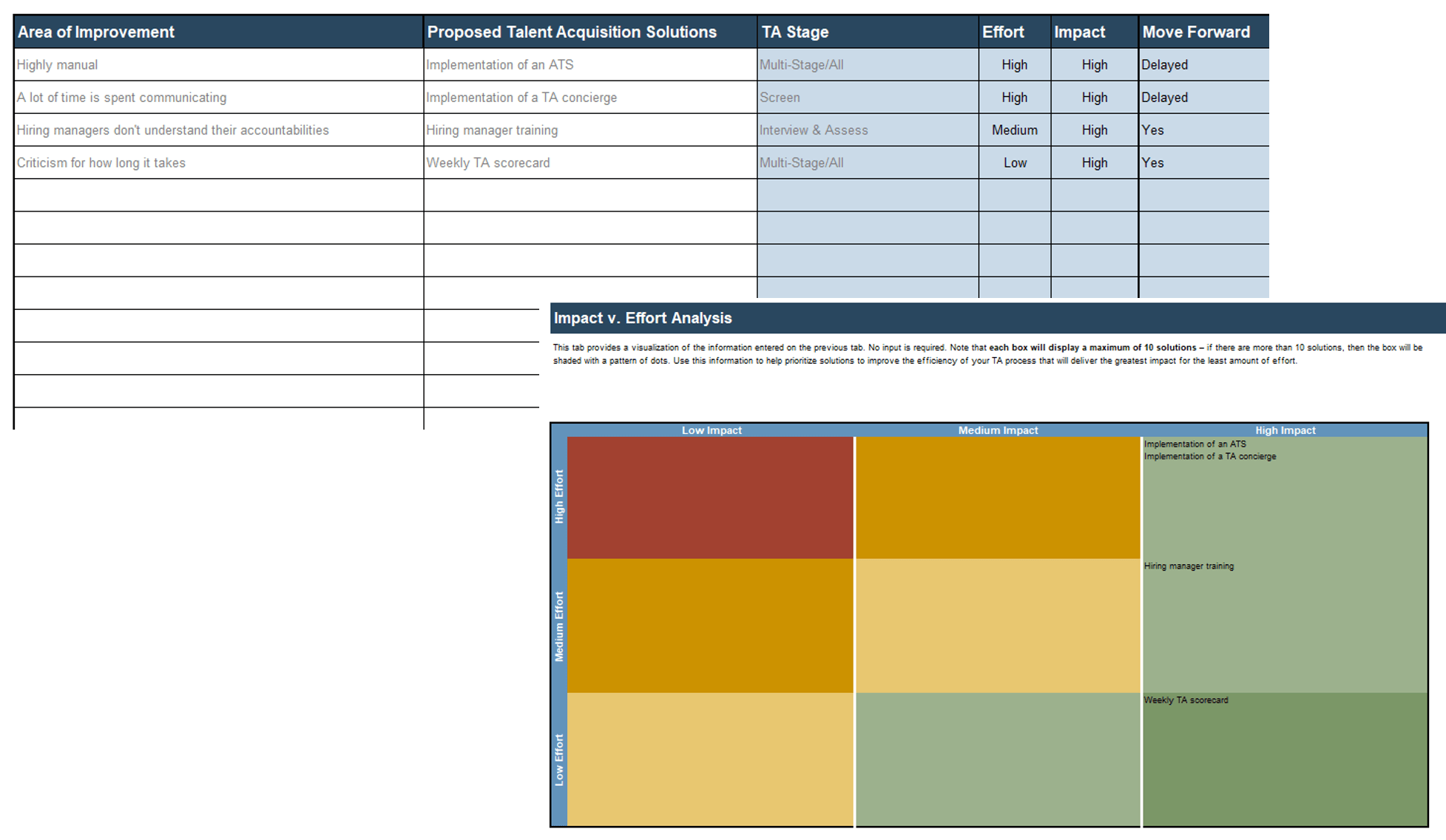
Key considerations when optimizing your process
- Put yourself in each stakeholder's shoes (candidate, HR, hiring manager). Think through what they need from the process.
- Challenge assumptions and norms. It can be tempting to get caught up in "how we do it today." Think beyond how it is today.
- Question timing of activities and events. Identify if they are occurring when they need to.
- Rebalance work to align with priorities. Identify if work can be redistributed or condensed to use time more efficiently.
- Distinguish when consistency will add value and when there should be process flexibility.
- Question the value. For each activity, ask "What value does this activity add?"
Select metrics to measure Talent Acquisition process improvement
| METRICS INFORMATION | ||
|---|---|---|
| Metric | Definition | Calculation |
| Average applicants per posting | The average number of applicants received per post. | Number of applications / Number of postings |
| Average number of interviews for open job positions | Average number of interviews for open job positions. | Total number of interviews / Total number of open job positions |
| Average external time to fill | Average number of calendar days from when the requisition is issued to when a candidate accepts the position from outside the organization. | External days to fill / External candidates |
| Pipeline throughput | Percentage of candidates advancing through to the next stage. | (Number of candidates in chosen stage / Number of candidates in preceding stage) * 100 |
| External offer acceptance rate | Percentage of job offers extended to external candidates that were accepted. | (Number of job offers that are accepted / Number of job offers extended) * 100 |
| Percentage of target group hired | The percentage of a target group that was hired. | Number of FTE hired / Target number of FTE to be hired |
| Average time to hire | Average number of calendar days between first contact with the candidate and when they accept the offer. | Sum of number of days between first contact and offer acceptance / External candidates |
| Quality of hire | Percentage of new hires achieving a satisfactory appraisal at their first assessment. | New hires who achieve a satisfactory rating at their first appraisal / Total number of new hires |
| Vacancy rate | Percentage of positions being actively recruited for at the end of the reporting period. | Count of vacant positions / (Headcount + Vacant positions) |
Bibliography
"81% of Employees Factoring Hybrid Work Into Job Search: Survey." BenefitsCanada.com, 16 June 2022.
Andre, Louie. "40 Notable Candidate Experience Statistics: 2023 Job Application Trends & Challenges." Financesonline.Com, 15 Mar. 2023.
Bika, Nikoletta. "Key Hiring Metrics: Useful Benchmarks for Tech Roles." Recruiting Resources: How to Recruit and Hire Better, 10 Jan. 2019.
"Bureau of Labor Statistics Labor Market Revisions Contribute to Conflicting Signals in Latest Tech Employment Data, CompTIA Analysis Finds." CompTIA, 3 Feb. 2023. Press release.
Byrnes, Amy. "ICIMS Insights Workforce Report: Time to Press the Reset Button?" ICIMS | The Leading Cloud Recruiting Software, 1 Dec. 2022.
Cantrell, Sue, et al. "The Skills-Based Organization: A New Operating Model for Work and the Workforce." Deloitte Insights, 8 Sept. 2022.
deBara, Deanna. "Top Findings from Lattice's Career Progression Survey." Lattice, 13 Sept. 2021. Accessed 16 Feb. 2023.
Duszyński, Maciej. "Candidate Experience Statistics (Survey of 1,000+ Americans)." Zety, 14 Oct. 2019.
Duszyński, Maciej. "Candidate Experience Statistics." Zety, 2021.
Echevarria, Desiree. "2020 Candidate Experience Report." Career Plug, 17 Mar. 2021.
Ghosh, Prarthana. "Candidate Screening and Selection Process: The Complete Guide for 2021." Spiceworks, 26 Feb. 2021. Accessed 22 Jun. 2021
"Introduction - Dice Tech Job Report: Tech Hiring Trends by Location, Industry, Role and Skill." Accessed 16 Feb. 2023.
Lee, Roger. "Tech Layoff Tracker and Startup Layoff Lists." Layoffs.fyi. Accessed 16 Feb. 2023.
Miller, Kandace. "Candidate Experience And Engagement Metrics You Should Be Tracking." ConveyIQ, n.d. Accessed 16 Feb. 2023.
Min, Ji-A. "Resume Screening: A How-To Guide for Recruiters." Ideal, 15 Mar. 2021. Web.
Palmeri, Shelby. "2023 Candidate Experience Research: Strategies for Recruiting." CareerPlug, 6 Feb. 2023.
Semenova, Alexandra. "Jobs Report: U.S. Economy Adds 517,000 Jobs in January, Unemployment Rate Falls to 3.4% as Labor Market Stuns." Yahoo!Finance, 3 Feb. 2023.
Sozzi, Brian. "Big Tech Layoffs: What Companies Such as Amazon and Meta Have in Common." Yahoo!News, 6 Feb. 2023.
Tarki, Atta. "Despite Layoffs, It's Still a Workers' Labor Market." Harvard Business Review, 30 Jan. 2023.
The Deloitte Global 2022 Gen Z and Millennial Survey. Deloitte Global, 2022. Accessed 16 Feb. 2023.
"Uncover the Employee Value Proposition." McLean & Company, 21 Jun. 2022. Accessed 22 Feb. 2023.